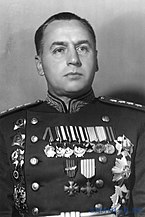The Warsaw Pact (WP),[d] formally the Treaty of Friendship, Cooperation and Mutual Assistance (TFCMA),[e] was a collective defense treaty signed in Warsaw, Poland, between the Soviet Union and seven other Eastern Bloc socialist republics of Central and Eastern Europe in May 1955, during the Cold War. The term "Warsaw Pact" commonly refers to both the treaty itself and its resultant defensive alliance, the Warsaw Treaty Organization[5] (WTO).[f] The Warsaw Pact was the military and economic complement to the Council for Mutual Economic Assistance (Comecon), the regional economic organization for the Eastern Bloc states of Central and Eastern Europe.[6][7][8][9][10][11][12][13][14][15][16]
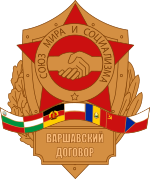 | |
 The Warsaw Pact in 1990 | |
| Abbreviation | TFCMA, WP |
|---|---|
| Successor | Collective Security Treaty Organization |
| Founded | 14 May 1955 |
| Founded at | Warsaw, Poland |
| Dissolved | 1 July 1991 |
| Headquarters | Moscow, Russian SFSR, Soviet Union |
Membership | |
| |
| |
| Affiliations | Council for Mutual Economic Assistance |
Dominated by the Soviet Union, the Warsaw Pact was established as a balance of power or counterweight to the North Atlantic Treaty Organization (NATO) and the Western Bloc.[17][18] There was no direct military confrontation between the two organizations; instead, the conflict was fought on an ideological basis and through proxy wars. Both NATO and the Warsaw Pact led to the expansion of military forces and their integration into the respective blocs.[18] The Warsaw Pact's largest military engagement was the Warsaw Pact invasion of Czechoslovakia, its own member state, in August 1968 (with the participation of all pact nations except Albania and Romania),[17] which, in part, resulted in Albania withdrawing from the pact less than one month later. The pact began to unravel with the spread of the Revolutions of 1989 through the Eastern Bloc, beginning with the Solidarity movement in Poland,[19] its electoral success in June 1989 and the Pan-European Picnic in August 1989.[20]
East Germany withdrew from the pact following German reunification in 1990. On 25 February 1991, at a meeting in Hungary, the pact was declared at an end by the defense and foreign ministers of the six remaining member states. The USSR itself was dissolved in December 1991, although most of the former Soviet republics formed the Collective Security Treaty Organization shortly thereafter. In the following 20 years, the Warsaw Pact countries outside the USSR each joined NATO (East Germany through its reunification with West Germany; and the Czech Republic and Slovakia as separate countries), as did the Baltic states.
History
Beginnings


Before the creation of the Warsaw Pact, the Czechoslovak leadership, fearful of a rearmed Germany, sought to create a security pact with East Germany and Poland.[13] These states protested strongly against the re-militarization of West Germany.[21] The Warsaw Pact was put in place as a consequence of the rearming of West Germany inside NATO. Soviet leaders, like many European leaders on both sides of the Iron Curtain, feared Germany being once again a military power and a direct threat. The consequences of German militarism remained a fresh memory among the Soviets and Eastern Europeans.[7][8][22][23][24] As the Soviet Union already had an armed presence and political domination all over its eastern satellite states by 1955, the pact has been long considered "superfluous",[25] and because of the rushed way in which it was conceived, NATO officials labeled it a "cardboard castle".[26]

The USSR, fearing the restoration of German militarism in West Germany, had suggested in 1954 that it join NATO, but this was rejected by the US.[27][28][29]
The Soviet request to join NATO arose in the aftermath of the Berlin Conference of January–February 1954. Soviet foreign minister Molotov made proposals to have Germany reunified[30] and elections for a pan-German government,[31] under conditions of withdrawal of the four powers' armies and German neutrality,[32] but all were refused by the other foreign ministers, Dulles (USA), Eden (UK), and Bidault (France).[33] Proposals for the reunification of Germany were nothing new: earlier on 20 March 1952, talks about a German reunification, initiated by the so-called 'Stalin Note', ended after the United Kingdom, France, and the United States insisted that a unified Germany should not be neutral and should be free to join the European Defence Community (EDC) and rearm. James Dunn (USA), who met in Paris with Eden, Konrad Adenauer, and Robert Schuman (France), affirmed that "the object should be to avoid discussion with the Russians and to press on the European Defense Community".[34] According to John Gaddis, "there was little inclination in Western capitals to explore this offer" from the USSR,[35] while historian Rolf Steininger asserts that Adenauer's conviction that "neutralization means sovietization", referring to the Soviet Union's policies towards Finland known as finlandization, was the main factor in the rejection of the Soviet proposals.[36] Adenauer also feared that German unification might have resulted in the end of the CDU's leading political role in the West German Bundestag.[37]
Consequently, Molotov, fearing that the EDC would be directed in the future against the USSR and "seeking to prevent the formation of groups of European States directed against the other European States",[38] made a proposal for a General European Treaty on Collective Security in Europe "open to all European States without regard to their social systems",[38] which would have included the unified Germany (thus rendering the EDC obsolete). But Eden, Dulles, and Bidault opposed the proposal.[39]
One month later, the proposed European Treaty was rejected not only by supporters of the EDC, but also by Western opponents of the European Defence Community (like French Gaullist leader Gaston Palewski) who perceived it as "unacceptable in its present form because it excludes the USA from participation in the collective security system in Europe".[40] The Soviets then decided to make a new proposal to the governments of the US, UK, and France to accept the participation of the US in the proposed General European Agreement.[40] As another argument deployed against the Soviet proposal was that it was perceived by Western powers as "directed against the North Atlantic Pact and its liquidation",[40][41] the Soviets decided to declare their "readiness to examine jointly with other interested parties the question of the participation of the USSR in the North Atlantic bloc", specifying that "the admittance of the USA into the General European Agreement should not be conditional on the three Western powers agreeing to the USSR joining the North Atlantic Pact".[40]

Again, all proposals, including the request to join NATO, were rejected by the UK, US, and French governments shortly after.[29][42] Emblematic was the position of British General Hastings Ismay, a fierce supporter of NATO expansion. He opposed the request to join NATO made by the USSR in 1954[43] saying that "the Soviet request to join NATO is like an unrepentant burglar requesting to join the police force".[44]
In April 1954, Adenauer made his first visit to the United States, meeting Nixon, Eisenhower, and Dulles. Ratification of the EDC was delayed but the US representatives made it clear to Adenauer that the EDC would have to become a part of NATO.[45]
Memories of the Nazi occupation were still strong, and the rearmament of Germany was feared by France too.[8][46] On 30 August 1954, the French Parliament rejected the EDC, thus ensuring its failure[47] and blocking a major objective of US policy towards Europe: to associate West Germany militarily with the West.[48] The US Department of State started to elaborate alternatives: West Germany would be invited to join NATO or, in the case of French obstructionism, strategies to circumvent a French veto would be implemented in order to obtain German rearmament outside NATO.[49]
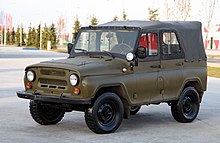
On 23 October 1954, the admission of the Federal Republic of Germany to the North Atlantic Pact was finally decided. The incorporation of West Germany into the organization on 9 May 1955 was described as "a decisive turning point in the history of our continent" by Halvard Lange, Foreign Affairs Minister of Norway at the time.[50] In November 1954, the USSR requested a new European Security Treaty,[51] in order to make a final attempt to not have a remilitarized West Germany potentially opposed to the Soviet Union, with no success.
On 14 May 1955, the USSR and seven other Eastern European countries "reaffirming their desire for the establishment of a system of European collective security based on the participation of all European states irrespective of their social and political systems"[52] established the Warsaw Pact in response to the integration of the Federal Republic of Germany into NATO,[7][9] declaring that: "a remilitarized Western Germany and the integration of the latter in the North-Atlantic bloc [...] increase the danger of another war and constitutes a threat to the national security of the peaceable states; [...] in these circumstances the peaceable European states must take the necessary measures to safeguard their security".[52]
One of the founding members, East Germany, was allowed to re-arm by the Soviet Union and the National People's Army was established as the armed forces of the country to counter the rearmament of West Germany.[53]
The USSR concentrated on its own recovery, seizing and transferring most of Germany's industrial plants, and it exacted war reparations from East Germany, Hungary, Romania, and Bulgaria using Soviet-dominated joint enterprises. It also instituted trading arrangements deliberately designed to favour the country. Moscow controlled the Communist parties that ruled the satellite states, and they followed orders from the Kremlin. Historian Mark Kramer concludes: "The net outflow of resources from eastern Europe to the Soviet Union was approximately $15 billion to $20 billion in the first decade after World War II, an amount roughly equal to the total aid provided by the United States to western Europe under the Marshall Plan."[54]
In November 1956, Soviet forces invaded Hungary, a Warsaw Pact member state, and violently put down the Hungarian Revolution. After that, the USSR made bilateral 20-year-treaties with Poland (17 December 1956),[55] the GDR (12 March 1957),[56] Romania (15 April 1957; Soviet forces were later removed as part of Romania's de-satellization),[57] and Hungary (27 May 1957),[58] ensuring that Soviet troops were deployed in these countries.
Members

The founding signatories of the Pact consisted of the following communist governments:
 People's Socialist Republic of Albania (withheld support in 1961 because of the Albanian–Soviet split, but formally withdrew on 13 September 1968)
People's Socialist Republic of Albania (withheld support in 1961 because of the Albanian–Soviet split, but formally withdrew on 13 September 1968) People's Republic of Bulgaria[59]
People's Republic of Bulgaria[59] Czechoslovak Socialist Republic[59]
Czechoslovak Socialist Republic[59] East Germany (German Democratic Republic; officially withdrew on 24 September 1990 in preparation for German reunification, with Soviet consent and a "remarkable yet hardly noticed" ceremony, ceasing to exist altogether at midnight on 3 October)[60][61][62][63][64]
East Germany (German Democratic Republic; officially withdrew on 24 September 1990 in preparation for German reunification, with Soviet consent and a "remarkable yet hardly noticed" ceremony, ceasing to exist altogether at midnight on 3 October)[60][61][62][63][64] Hungarian People's Republic (temporarily withdrew from 1–4 November 1956 during the Hungarian Revolution)[59]
Hungarian People's Republic (temporarily withdrew from 1–4 November 1956 during the Hungarian Revolution)[59] Polish People's Republic[59]
Polish People's Republic[59] Socialist Republic of Romania (the only independent permanent non-Soviet member of the Warsaw Pact, having freed itself from its Soviet satellite status by the early 1960s)[1][2]
Socialist Republic of Romania (the only independent permanent non-Soviet member of the Warsaw Pact, having freed itself from its Soviet satellite status by the early 1960s)[1][2] Soviet Union[59]
Soviet Union[59]
Observers
 Mongolia: In July 1963, the Mongolian People's Republic asked to join the Warsaw Pact under Article 9 of the treaty.[65] Due to the emerging Sino-Soviet split, Mongolia remained in an observer status.[65] In what was the first instance of a Soviet initiative being blocked by a non-Soviet member of the Warsaw Pact, Romania blocked Mongolia's accession to the Warsaw Pact.[66][67] The Soviet government agreed to station troops in Mongolia in 1966.[68]
Mongolia: In July 1963, the Mongolian People's Republic asked to join the Warsaw Pact under Article 9 of the treaty.[65] Due to the emerging Sino-Soviet split, Mongolia remained in an observer status.[65] In what was the first instance of a Soviet initiative being blocked by a non-Soviet member of the Warsaw Pact, Romania blocked Mongolia's accession to the Warsaw Pact.[66][67] The Soviet government agreed to station troops in Mongolia in 1966.[68]
At first, China, North Korea, and North Vietnam had observer status,[69] but China withdrew in 1961 as a consequence of the Albanian-Soviet split, in which China backed Albania against the USSR as part of the larger Sino-Soviet split of the early 1960s.[70]
During the Cold War

For 36 years, NATO and the Warsaw Pact never directly waged war against each other in Europe; the United States and the Soviet Union and their respective allies implemented strategic policies aimed at the containment of each other in Europe, while working and fighting for influence within the wider Cold War on the international stage. These included the Korean War, Vietnam War, Bay of Pigs invasion, Dirty War, Cambodian–Vietnamese War, and others.[72][73]
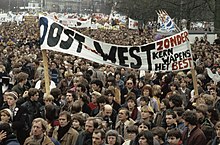
In 1956, following the declaration of the Imre Nagy government of the withdrawal of Hungary from the Warsaw Pact, Soviet troops entered the country and removed the government.[74] Soviet forces crushed the nationwide revolt, leading to the death of an estimated 2,500 Hungarian citizens.[75]
The multi-national Communist armed forces' sole joint action was the Warsaw Pact invasion of Czechoslovakia, another Warsaw Pact member state, in August 1968.[76] All member countries, with the exception of the Socialist Republic of Romania and the People's Republic of Albania, participated in the invasion.[77] The German Democratic Republic provided only minimal support.[77] (Albania withdrew from the pact one month after this intervention.)
End of the Cold War

In 1989, popular civil and political public discontent toppled the Communist governments of the Warsaw Treaty countries. The beginning of the end of the Warsaw Pact, regardless of military power, was the Pan-European Picnic in August 1989. The event, which goes back to an idea by Otto von Habsburg, caused the mass exodus of GDR citizens and the media-informed population of Eastern Europe felt the loss of power of their rulers and the Iron Curtain broke down completely. Though Poland's new Solidarity government under Lech Wałęsa initially assured the Soviets that it would remain in the Pact,[78] this broke the brackets of Eastern Europe, which could no longer be held together militarily by the Warsaw Pact.[79][80][81] Independent national politics made feasible with the perestroika and liberal glasnost policies revealed shortcomings and failures (i.e. of the soviet-type economic planning model) and induced institutional collapse of the Communist government in the USSR in 1991.[82][better source needed] From 1989 to 1991, Communist governments were overthrown in Albania, Poland, Hungary, Czechoslovakia, East Germany, Romania, Bulgaria, Yugoslavia, and the Soviet Union.
As the last acts of the Cold War were playing out, several Warsaw Pact states (Poland, Czechoslovakia, and Hungary) participated in the US-led coalition effort to liberate Kuwait in the Gulf War.
On 25 February 1991, the Warsaw Pact was declared disbanded at a meeting of defence and foreign ministers from remaining Pact countries meeting in Hungary.[83] On 1 July 1991, in Prague, the Czechoslovak President Václav Havel[84] formally ended the 1955 Warsaw Treaty Organization of Friendship, Cooperation and Mutual Assistance and so disestablished the Warsaw Treaty after 36 years of military alliance with the USSR.[84][85] The USSR disestablished itself in December 1991.
Structure
The Warsaw Treaty's organization was two-fold: the Political Consultative Committee handled political matters, and the Combined Command of Pact Armed Forces controlled the assigned multi-national forces, with headquarters in Warsaw, Poland.
Although an apparently similar collective security alliance, the Warsaw Pact differed substantially from NATO. De jure, the eight-member countries of the Warsaw Pact pledged the mutual defense of any member who would be attacked; relations among the treaty signatories were based upon mutual non-intervention in the internal affairs of the member countries, respect for national sovereignty, and political independence.[86]
However, de facto, the Pact was a direct reflection of the USSR's authoritarianism and undisputed domination over the Eastern Bloc, in the context of the so-called Soviet Empire, which was not comparable to that of the United States over the Western Bloc.[87] All Warsaw Pact commanders had to be, and have been, senior officers of the Soviet Union at the same time and appointed for an unspecified term length: the Supreme Commander of the Unified Armed Forces of the Warsaw Treaty Organization, which commanded and controlled all the military forces of the member countries, was also a First Deputy Minister of Defence of the USSR, and the Chief of Combined Staff of the Unified Armed Forces of the Warsaw Treaty Organization was also a First Deputy Chief of the General Staff of the Soviet Armed Forces.[88] On the contrary, the Secretary General of NATO and Chair of the NATO Military Committee are positions with fixed term of office held on a random rotating basis by officials from all member countries through consensus.
Despite the American hegemony (mainly military and economic) over NATO, all decisions of the North Atlantic Alliance required unanimous consensus in the North Atlantic Council and the entry of countries into the alliance was not subject to domination but rather a natural democratic process.[87] In the Warsaw Pact, decisions were ultimately taken by the Soviet Union alone; the countries of the Warsaw Pact were not equally able to negotiate their entry in the Pact nor the decisions taken.[87]
Although nominally a "defensive" alliance, the Pact's primary function was to safeguard the Soviet Union's hegemony over its Eastern European satellites, with the Pact's only direct military actions having been the invasions of its own member states to keep them from breaking away.[89]
Romania and Albania
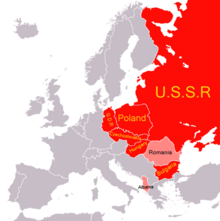
Romania and, until 1968, Albania – were exceptions. Together with Yugoslavia, which broke with the Soviet Union before the Warsaw Pact was created, these three countries completely rejected the Soviet doctrine formulated for the Pact. Albania officially left the organization in 1968, in protest of its invasion of Czechoslovakia. Romania had its own reasons for remaining a formal member of the Warsaw Pact, such as Nicolae Ceaușescu's interest of preserving the threat of a Pact invasion so he could sell himself as a nationalist, as well as privileged access to NATO counterparts and a seat at various European forums which otherwise he would not have had (for instance, Romania and the Soviet-led remainder of the Warsaw Pact formed two distinct groups in the elaboration of the Helsinki Final Act).[90] When Andrei Grechko assumed command of the Warsaw Pact, both Romania and Albania had for all practical purposes defected from the Pact. In the early 1960s, Grechko initiated programs meant to preempt Romanian doctrinal heresies from spreading to other Pact members. Romania's doctrine of territorial defense threatened the Pact's unity and cohesion. No other country succeeded in escaping from the Warsaw Pact like Romania and Albania did. For example, the mainstays of Romania's tank forces were locally developed models. Soviet troops were deployed to Romania for the last time in 1963, as part of a Warsaw Pact exercise. After 1964, the Soviet Army was barred from returning to Romania, as the country refused to take part in joint Pact exercises.[91]

Even before the advent of Nicolae Ceaușescu, Romania was in fact an independent country, as opposed to the rest of the Warsaw Pact. To some extent, it was even more independent than Cuba (a communist Soviet-aligned state that was not a member of the Warsaw Pact).[1] The Romanian regime was largely impervious to Soviet political influence, and Ceaușescu was the only declared opponent of glasnost and perestroika. On account of the contentious relationship between Bucharest and Moscow, the West did not hold the Soviet Union responsible for the policies pursued by Bucharest. This was not the case for the other countries in the region, such as Czechoslovakia and Poland.[93] At the start of 1990, the Soviet foreign minister, Eduard Shevardnadze, implicitly confirmed the lack of Soviet influence over Ceaușescu's Romania. When asked whether it made sense for him to visit Romania less than two weeks after its revolution, Shevardnadze insisted that only by going in person to Romania could he figure out how to "restore Soviet influence".[94]
Romania requested and obtained the complete withdrawal of the Soviet Army from its territory in 1958. The Romanian campaign for independence culminated on 22 April 1964 when the Romanian Communist Party issued a declaration proclaiming that: "Every Marxist–Leninist Party has a sovereign right...to elaborate, choose or change the forms and methods of socialist construction." and "There exists no "parent" party and "offspring" party, no "superior" and "subordinated" parties, but only the large family of communist and workers' parties having equal rights." and also "there are not and there can be no unique patterns and recipes". This amounted to a declaration of political and ideological independence from Moscow.[95][96][97][98]

Following Albania's withdrawal from the Warsaw Pact, Romania remained the only Pact member with an independent military doctrine which denied the Soviet Union use of its armed forces and avoided absolute dependence on Soviet sources of military equipment.[100] Romania was the only non-Soviet Warsaw Pact member which was not obliged to militarily defend the Soviet Union in case of an armed attack.[101] Bulgaria and Romania were the only Warsaw Pact members that did not have Soviet troops stationed on their soil.[102] In December 1964, Romania became the only Warsaw Pact member (save Albania, which would leave the Pact altogether within 4 years) from which all Soviet advisors were withdrawn, including those in the intelligence and security services.[103] Not only did Romania not participate in joint operations with the KGB, but it also set up "departments specialized in anti-KGB counterespionage".[104]
Romania was neutral in the Sino-Soviet split.[105][106][107] Its neutrality in the Sino-Soviet dispute along with being the small Communist country with the most influence in global affairs enabled Romania to be recognized by the world as the "third force" of the Communist world. Romania's independence – achieved in the early 1960s through its freeing from its Soviet satellite status – was tolerated by Moscow because Romania was not bordering the Iron Curtain – being surrounded by socialist states – and because its ruling party was not going to abandon communism.[2][108][109]
Although certain historians such as Robert King and Dennis Deletant argue against the usage of the term "independent" to describe Romania's relations with the Soviet Union, favoring "autonomy" instead on account of the country's continued membership within both the Comecon and the Warsaw Pact along with its commitment to socialism, this approach fails to explain why in July 1963 Romania blocked Mongolia's accession to the Warsaw Pact, why in November 1963 Romania voted in favor of a UN resolution to establish a nuclear-free zone in Latin America when the other Soviet-aligned countries abstained, or why in 1964 Romania opposed the Soviet-proposed "strong collective riposte" against China (and these are examples solely from the 1963–1964 period).[110] Soviet disinformation tried to convince the West that Ceaușescu's empowerment was a dissimulation in connivance with Moscow.[111] To an extent this worked, as some historians came to see the hand of Moscow behind every Romanian initiative. For instance, when Romania became the only Eastern European country to maintain diplomatic relations with Israel, some historians have speculated that this was at Moscow's whim. However, this theory fails upon closer inspection.[112] Even during the Cold War, some thought that Romanian actions were done at the behest of the Soviets, but Soviet anger at said actions was "persuasively genuine". In truth, the Soviets were not beyond publicly aligning themselves with the West against the Romanians at times.[113]
Strategy
The strategy behind the formation of the Warsaw Pact was driven by the desire of the Soviet Union to prevent Central and Eastern Europe being used as a base for its enemies. Its policy was also driven by ideological and geostrategic reasons. Ideologically, the Soviet Union arrogated the right to define socialism and communism and act as the leader of the global socialist movement. A corollary to this was the necessity of military intervention if a country appeared to be "violating" core socialist ideas, i.e. breaking away from the Soviet sphere of influence, explicitly stated in the Brezhnev Doctrine.[114]
Notable military exercises
| External videos | |
|---|---|
 Czechoslovak Military Parade "Shield-84" – Vojenská přehlídka ČSLA "Štít-84 Czechoslovak Military Parade "Shield-84" – Vojenská přehlídka ČSLA "Štít-84 |
- "Szczecin" (Poland, 1962)
- "Vltava" (Czechoslovakia, 1966)
- Operation "Rhodope" (Bulgaria, 1967)
- "Oder-Neisse" (East Germany, 1969)
- Przyjaźń 84 (Poland, 1984)
- Shield 84 (Czechoslovakia, 1984)[115]
NATO and Warsaw Pact: comparison of the two forces
NATO and Warsaw Pact forces in Europe
| NATO estimates | Warsaw Pact estimates | |||
| Type | NATO | Warsaw Pact | NATO | Warsaw Pact |
| Personnel | 2,213,593 | 3,090,000 | 3,660,200 | 3,573,100 |
| Combat aircraft | 3,977 | 8,250 | 7,130 | 7,876 |
| Total strike aircraft | NA | NA | 4,075 | 2,783 |
| Helicopters | 2,419 | 3,700 | 5,720 | 2,785 |
| Tactical missile launchers | NA | NA | 136 | 1,608 |
| Tanks | 16,424 | 51,500 | 30,690 | 59,470 |
| Anti-tank weapons | 18,240 | 44,200 | 18,070 | 11,465 |
| Armored infantry fighting vehicles | 4,153 | 22,400 | 46,900 | 70,330 |
| Artillery | 14,458 | 43,400 | 57,060 | 71,560 |
| Other armored vehicles | 35,351 | 71,000 | ||
| Armored vehicle launch bridges | 454 | 2,550 | ||
| Air defense systems | 10,309 | 24,400 | ||
| Submarines | 200 | 228 | ||
| Submarines (nuclear powered) | 76 | 80 | ||
| Large surface ships | 499 | 102 | ||
| Aircraft-carrying ships | 15 | 2 | ||
| Aircraft-carrying ships armed with cruise missiles | 274 | 23 | ||
| Amphibious warfare ships | 84 | 24 | ||
Post–Warsaw Pact

On 12 March 1999, the Czech Republic, Hungary, and Poland joined NATO; Bulgaria, Estonia, Latvia, Lithuania, Romania, Slovenia and Slovakia joined in March 2004; Croatia and Albania joined on 1 April 2009.[117][118]
The USSR's successor Russia and some other post-Soviet states joined the Collective Security Treaty Organization (CSTO) in 1992, and the Shanghai Five in 1996, which was renamed the Shanghai Cooperation Organisation (SCO) after Uzbekistan's addition in 2001.[citation needed]
In November 2005, the Polish government opened its Warsaw Treaty archives to the Institute of National Remembrance, which published some 1,300 declassified documents in January 2006, yet the Polish government reserved publication of 100 documents, pending their military declassification. Eventually, 30 of the reserved 100 documents were published; 70 remained secret and unpublished. Among the documents published was the Warsaw Treaty's nuclear war plan, Seven Days to the River Rhine – a short, swift invasion and capture of Austria, Denmark, Germany, and the Netherlands east of the Rhine, using nuclear weapons after a supposed NATO first strike.[119][120]
See also
- Eastern Bloc
- Finno-Soviet Treaty of 1948 – treaty that defined Finland's level of neutrality towards Soviet Union
- Finlandization – the USSR's influence on Finland following the treaty
- Russosphere
- Soviet Empire
- Sovietization
- Treaty of friendship – any treaty establishing close ties between countries
Explanatory notes
References
Citations
Works cited
Further reading
Other languages
Memoirs
External links

- "What was the Warsaw Pact?". North Atlantic Treaty Organization.
- The Woodrow Wilson Center Cold War International History Project's Warsaw Pact Document Collection
- Parallel History Project on Cooperative Security
- Library of Congress / Federal Research Division / Country Studies / Area Handbook Series / Soviet Union / Appendix C: The Warsaw Pact (1989)
- Map of Russia and the Warsaw Pact (omniatlas.com)
- Soviet Nuclear Weapons in Hungary 1961–1991
- The Warsaw Pact, 1955–1968 by Hugh Collins Embry. Contain extensive documentation of the Pact's first 13 years.









